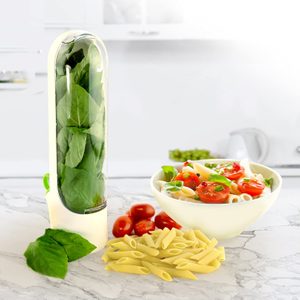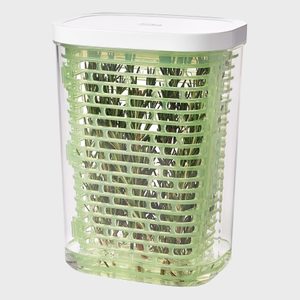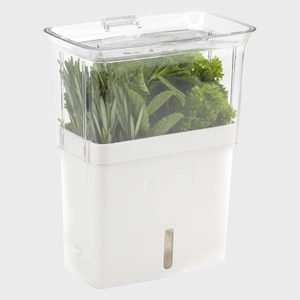The Best Way to Store Fresh Herbs
Updated: Mar. 14, 2023
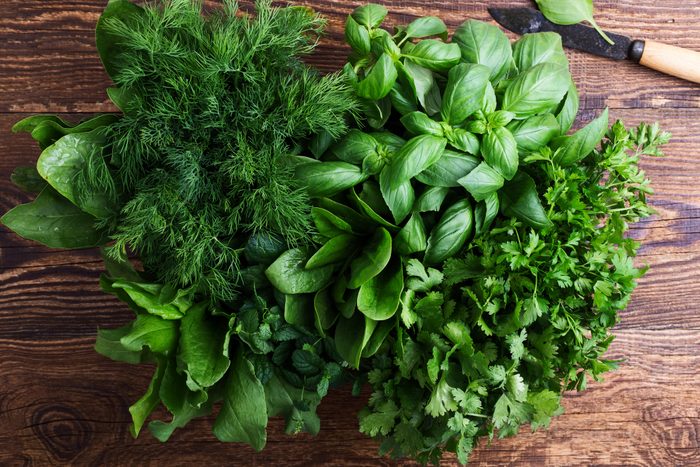
Love cooking with fresh herbs but hate how fast they wilt? These expert tips on how to store fresh herbs are the solution you've been waiting for.
There’s something special about cooking with fresh herbs. Their appearance, scent and taste can conjure powerful memories, they’re an easy way to connect with nature and they usually improve the flavor and texture of foods, says Angelo Randaci, a master gardener and horticulturist with Earth’s Ally who’s an expert in kitchen gardens. The only issue for many home cooks—and it’s a big one—is how to store fresh herbs so they don’t go bad before you can use them.
“There is nothing like fresh herbs for cooking. They please all the senses,” he says. “I can still taste my Sicilian mother’s spaghetti sauce, made from tomatoes and handfuls of fresh herbs from our garden: parsley, basil, thyme and savory.”
Not everyone can pull them straight from the garden, however. And because they aren’t nonperishable foods, store-bought herbs tend to go bad fast. (They don’t exactly come with a sell-by date!) No one likes wasting food or money, but thankfully there are some techniques you can use to store fresh herbs in your kitchen and keep them fresh for a week or even longer, says Randaci. (Step one: Ditch the gross plastic bag from the store!)
When you’ve mastered the art of herb storage, up your cooking game by reading about the best fridge-organization techniques and how to store produce.
Types of fresh herbs
Herbs fall into two different categories of plants. It’s important to know which type of herb you are using, as they require different growing, storage and cooking techniques.
Soft, or tender, herbs: These plants have delicate green stems that you can eat and are easily bruised or crushed. Basil, chives, cilantro, dill, mint, parsley and tarragon all fall into this category.
Hard, or robust, herbs: These plants have tough, woody stalks that you wouldn’t eat and can stand up to more handling. In this group, you’ll find thyme, rosemary, bay, oregano and sage.
One thing they all have in common is the ability to give food a bright, fresh flavor. And they’re not exclusively for savory dishes. You’ll certainly find them there: chives in umami-rich miso soup, oregano on pizza and thyme covering roasted chicken. But you’ll also come across herbed sweets like rosemary shortbread cookies and lavender-infused cake. And let’s not forget chocolate-mint ice cream!
| Soft herbs have delicate green stems you can eat, while hard herbs have tough, woody stems you don’t want to eat. |
How to store fresh herbs
Picking the right herb for your recipe and finding it at the store is only half the battle. The other necessity is keeping it fresh and flavorful until you use it.
Wondering how to store herbs so they’ll last longer than a day or two? You have four main storage methods to choose from.
The pot method
Best for: All types of herbs!
Remember this food fact, and you’ll have a steady supply of herbs for cooking: To have the freshest herbs, keep them alive and harvest them from the plant as you need them. This isn’t as tough as you may think, says Randaci, as most herbs grow very well in small pots indoors. “Kitchen herbs can grow for months indoors, even under artificial lights,” he says.
How to do it:
- Place plants in small pots with potting soil.
- Water them regularly.
- Keep them at room temperature.
If you want to take it to the next level, try hydroponic gardening, which you can do in small spaces and without soil.
The jar method
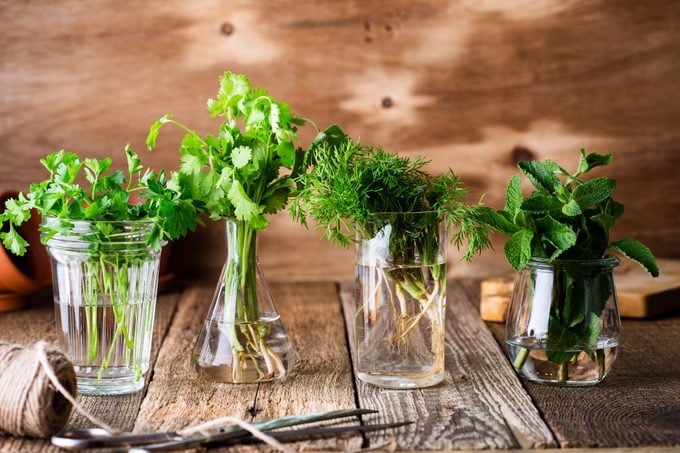
Best for: Tender herbs
So you’re looking into how to store fresh cilantro or how to store fresh basil. Tender herbs keep best when treated like cut flowers. So place them in a container of water and store them in a cool location, says Randaci. That may be a counter in a cool room or a shelf in your fridge—even a mini fridge will do the trick!
How to do it:
- Wash the herbs gently in clean water and pat them dry or spin them dry in a salad spinner.
- Trim the stems with a sharp knife and remove any brown leaves.
- Fill a mason jar with an inch or two of water. Place the herbs upright inside with their stems in the water.
- If you’re storing them on a countertop, add a small plastic bag loosely over the top to create a greenhouse effect.
- If you’re storing them in the fridge, leave the jar open or cover the jar with a lid (if one fits over the tuft of herbs).
- Change the water every two days.
Generally, this will keep herbs like basil, parsley, mint and cilantro fresh for one to two weeks, depending on how fresh they were when you got them. Some tender herbs, like chives, garlic and green onions, can last a month or longer in a jar of water. (Pro tip: You can propagate herbs—grow more from the plant clippings—by taking the steps above and then planting the herbs in your outdoor garden in the spring.)
The bag method
Best for: Hard herbs
You know how to store fresh parsley now, but what about how to store fresh rosemary and other robust herbs? Randaci recommends treating hard herbs like veggies and storing them in the crisper drawer in your refrigerator.
How to do it:
- Wash the herbs gently in clean water and pat them dry or spin them dry in a salad spinner.
- Wrap them gently in damp paper towels.
- Place them inside a plastic zip-top bag.
- Put the bag in a climate-controlled drawer in your fridge, like the vegetable crisper.
Generally, this will keep herbs like thyme, rosemary and sage fresh for one to three weeks, depending on how fresh they were when you got them.
Herb savers
If you use a lot of fresh-cut herbs and don’t want to grow them as plants, you can invest in an herb saver. These food storage containers are designed specifically for herb storage, controlling the humidity and temperature to keep herbs happy. Some herb savers sit on your countertop, while others go inside the fridge. Be sure to read and follow the instructions to know exactly how to store fresh herbs in your particular device.
How long do herbs last?
How you store food plays a major role in how long it lasts in the fridge. Without proper storage, expect fresh herbs to last one to two days. But stored properly, fresh herbs can last weeks or even longer. And yes, they’re perfectly safe to eat, according to the Food and Drug Administration.
| Tender Herbs | Days in the Fridge |
| Mint | 1–2 weeks |
| Lemon balm | 1–2 weeks |
| Basil | 2 weeks |
| Cilantro | 3 weeks |
| Dill | 3 weeks |
| Tarragon | 3 weeks |
| Parsley | 3–4 weeks |
| Chives and green onions | 3 weeks–2 months, or even longer in water |
| Hard Herbs | Days in the Fridge |
| Bay | 2 weeks |
| Oregano | 2 weeks |
| Thyme | 2 weeks |
| Sage | 2 weeks |
| Savory | 2 weeks |
| Rosemary | 3 weeks |
Can you freeze fresh herbs?
You can freeze a wide variety of foods—including most herbs. If you’re looking into how to store fresh herbs for extended periods of time, skip the fridge and move on to the freezer.
But before you start worrying that your frozen herbs have gone bad, know this: Upon thawing, they will look dark and wilted. But while they may not be ideal for use as garnishes or in salads, they’ll be flavorful and fresh for cooking.
Wondering how to store fresh mint and other herbs in the freezer? You have four easy-to-follow processes to choose from.
The bag method
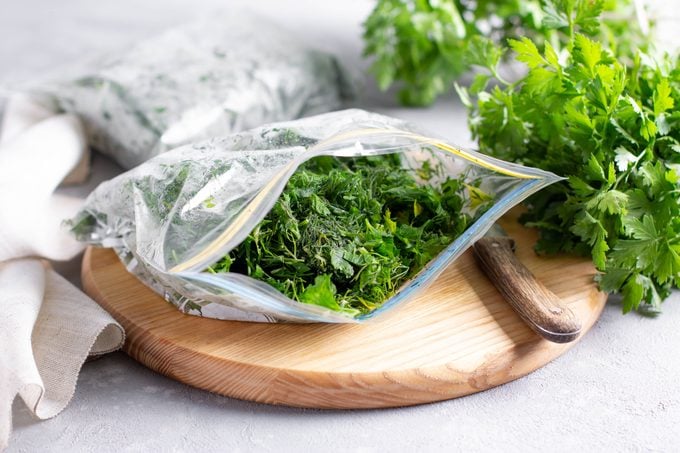
- Wash, pat dry and chop the herbs. Discard any woody stems.
- Place the herbs in a plastic bag.
- Add a dab of oil to the bag, close the top and shake to coat the herbs.
- Squeeze all the air out and place the bag in the freezer.
The puree method
- Wash, pat dry and chop the herbs. Discard any woody stems.
- Place the herbs in a food processor or blender.
- Add a little bit of oil and pulse.
- Freeze the herbs in ice cube trays or small zip-top bags.
The pan method
- Wash, pat dry and chop hard herbs. (Don’t use this method for tender herbs.) You can keep stems intact if you wish.
- Place the herbs on a cookie sheet. Freeze it for 24 hours.
- Remove the herbs from the sheet and place them in an airtight container with a lid. (Glass can go in the freezer, so either that or plastic will do.)
The ice cube method
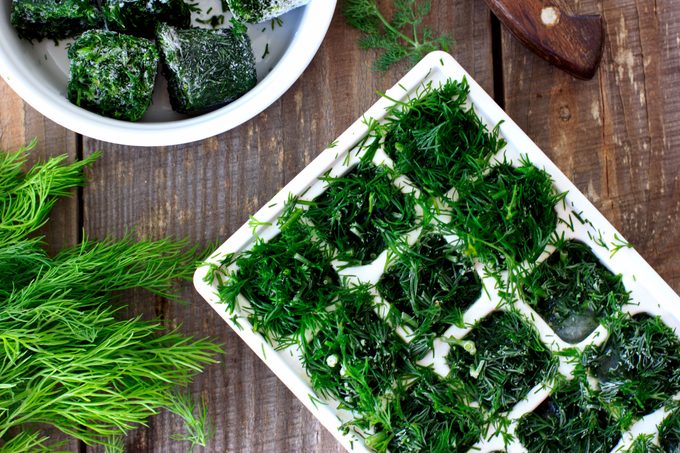
- Wash, pat dry and chop the herbs. Discard any woody stems.
- Place one serving in each square of a clean ice cube tray.
- Cover the herbs with water and freeze the tray.
- Pop out the ice cubes and store them in a zip-top bag.
And there you have it: Foolproof ways to store fresh herbs in the refrigerator and freezer. Now that you know how to store fresh dill and other herbs, learn how to prevent freezer burn and how long food will last in a fridge without power.
Get Reader’s Digest’s Read Up newsletter for more tips on food, cleaning, travel and tech, plus humor and fun facts, all week long.
Sources:
- Angelo Randaci, master gardener, horticulturist and rare plant expert with Earth’s Ally
- Food and Drug Administration: “Storing Raw Produce”

